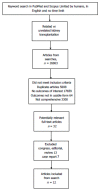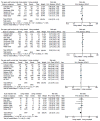Living related and living unrelated kidney transplantations: A systematic review and meta-analysis
- PMID: 28507918
- PMCID: PMC5409915
- DOI: 10.5500/wjt.v7.i2.152
Living related and living unrelated kidney transplantations: A systematic review and meta-analysis
Abstract
Aim: To compare the outcomes between related and unrelated kidney transplantations.
Methods: Literature searches were performed following the Cochrane guidelines. We conducted a systematic review and a meta-analysis, which included 12 trials that investigated outcomes including the long-term (ten years), mid-term (one to five years), and short-term (one year) graft survival rate as well as the acute rejection rate. Meta-analyses were performed using fixed and random-effects models, which included tests for publication bias and heterogeneity.
Results: No difference in graft survival rate was detected in patients who underwent living related kidney transplantations compared to unrelated (P = 0.44) transplantations after ten years. There were no significant differences between the graft survival rate in living related and unrelated kidney transplantations after a short- and mid-term follow-up (P = 0.35, P = 0.46). There were no significant differences between the acute rejection rate in living related and unrelated kidney transplantations (P = 0.06).
Conclusion: The long, mid and short term follow-up of living related and unrelated kidney transplantation showed no significant difference in graft survival rate. Also, acute rejection rate was not significantly different between groups.
Keywords: Graft survival rate; Living related; Living unrelated; Transplantation.
Conflict of interest statement
Conflict-of-interest statement: The authors deny any conflict of interest.
Figures



Similar articles
-
Outcomes of kidney transplantation from older living donors to older recipients.Am J Kidney Dis. 2008 Sep;52(3):541-52. doi: 10.1053/j.ajkd.2008.05.017. Epub 2008 Jul 24. Am J Kidney Dis. 2008. PMID: 18653267
-
Long-term results of ABO-incompatible living kidney transplantation: a single-center experience.Transplantation. 1998 Jan 27;65(2):224-8. doi: 10.1097/00007890-199801270-00014. Transplantation. 1998. PMID: 9458019
-
[Results of kidney transplantation at the Institute of Urology and Nephrology of the Serbian Clinical Center in Belgrade].Srp Arh Celok Lek. 2000 May-Jun;128(5-6):149-56. Srp Arh Celok Lek. 2000. PMID: 11089414 Serbian.
-
Clinical outcomes after ABO-incompatible renal transplantation: a systematic review and meta-analysis.Lancet. 2019 May 18;393(10185):2059-2072. doi: 10.1016/S0140-6736(18)32091-9. Epub 2019 Apr 18. Lancet. 2019. PMID: 31006573
-
Calcineurin inhibitor avoidance and withdrawal for kidney transplantation: a systematic review and meta-analysis of randomized controlled trials.Transplant Proc. 2014 Jun;46(5):1302-13. doi: 10.1016/j.transproceed.2014.02.010. Transplant Proc. 2014. PMID: 24935293
Cited by
-
Reasons and effects of the decline of willing related potential living kidney donors.World J Transplant. 2023 Sep 18;13(5):276-289. doi: 10.5500/wjt.v13.i5.276. World J Transplant. 2023. PMID: 37746040 Free PMC article.
-
Association Between Donor-Recipient Biological Relationship and Allograft Outcomes After Living Donor Kidney Transplant.JAMA Netw Open. 2021 Apr 1;4(4):e215718. doi: 10.1001/jamanetworkopen.2021.5718. JAMA Netw Open. 2021. PMID: 33847748 Free PMC article.
-
Pearls and Pitfalls in Pediatric Kidney Transplantation After 5 Decades.Front Pediatr. 2022 Apr 8;10:856630. doi: 10.3389/fped.2022.856630. eCollection 2022. Front Pediatr. 2022. PMID: 35463874 Free PMC article.
-
[The effects of preoperative anxiety on anesthetic recovery and postoperative pain in patients undergoing donor nephrectomy].Braz J Anesthesiol. 2020 May-Jun;70(3):271-277. doi: 10.1016/j.bjan.2020.03.010. Epub 2020 Jun 18. Braz J Anesthesiol. 2020. PMID: 32653228 Free PMC article.
-
Effect of the similarity of gut microbiota composition between donor and recipient on graft function after living donor kidney transplantation.Sci Rep. 2020 Nov 3;10(1):18881. doi: 10.1038/s41598-020-76072-8. Sci Rep. 2020. PMID: 33144672 Free PMC article.
References
-
- Moeller S, Gioberge S, Brown G. ESRD patients in 2001: global overview of patients, treatment modalities and development trends. Nephrol Dial Transplant. 2002;17:2071–2076. - PubMed
-
- Schnuelle P, Lorenz D, Trede M, Van Der Woude FJ. Impact of renal cadaveric transplantation on survival in end-stage renal failure: evidence for reduced mortality risk compared with hemodialysis during long-term follow-up. J Am Soc Nephrol. 1998;9:2135–2141. - PubMed
-
- Sesso R, Josephson MA, Anção MS, Draibe SA, Sigulem D. A retrospective study of kidney transplant recipients from living unrelated donors. J Am Soc Nephrol. 1998;9:684–691. - PubMed
-
- Ghods AJ. Renal transplantation in Iran. Nephrol Dial Transplant. 2002;17:222–228. - PubMed
-
- Simforoosh N, Basiri A, Tabibi A, Javanmard B, Kashi AH, Soltani MH, Obeid K. Living Unrelated Versus Related Kidney Transplantation: A 25-Year Experience with 3716 Cases. Urol J. 2016;13:2546–2551. - PubMed
LinkOut - more resources
Full Text Sources
Other Literature Sources

